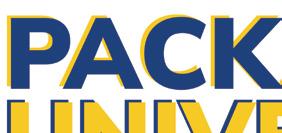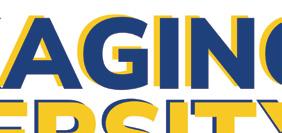
6 minute read
AICC INNOVATION
Headline
BYLINE
Advertisement
Professional Development
The Netfl ix for Packaging Education
AICC has launched two new ways to learn online: AICC Now and Packaging University.
AICC has brought many of its videos and information to AICC Now, a new information hub allowing members to fi nd it all in one place. AICC Now is a streaming platform, with recordings of AICC webinars, one-point lessons, PSAs, and more.
AICC has also revamped its free online education and launched Packaging University. More than 90 free online courses are still available to members at no charge, and now it is easier than ever to access it. Packaging University has an updated course list and a new look to help employees of member companies grow.
See it in action at now.aiccbox.org and learning.aiccbox.org.



Thought Leadership
Can Packaging Companies Really Embrace Market Dynamics?
BY BART VERBRUGGEN
While producers of paperboard packaging have always had their share of challenges, current market dynamics make it even harder to run their businesses. Demand is becoming more volatile, less predictable, more diverse, and more customer-specific than ever before. E-commerce and home delivery are changing the landscape, and the COVID-19 pandemic has made it all even more difficult to predict.
The Continuous Struggle Becomes More Challenging
I see many packaging companies struggle with orders coming in at the last minute. They find it difficult to make realistic service promises and then live up to those promises throughout the planning and production process. The need to produce ever-smaller batches of highly customized boxes while maintaining reasonable levels of stock and work in process makes it hard to schedule and optimize their corrugator and converting lines.
The continuing pressure for shorter lead times results in a growing number of items being managed in a maketo-stock arrangement, which brings the additional challenge of combining make-to-stock with make-to-order, competing for time on the same machines. And don’t forget that companies need to further reduce waste and increase efficiencies in this era of extremely fast fulfillment.
Why It’s Good to Invest in Forecasting
But there is also good news. Packaging companies can benefit a lot if they upgrade some of their planning practices and solutions. A prime example lies in forecasting demand. Many companies currently refrain from doing anything in this area, simply because they believe it’s too difficult and not very reliable.
They should think again. Indeed, state-of-the-art forecasting solutions are able to distinguish exceptional historical data from normal data and can even make a good guess at what next month’s new normal will be like. Forecasting techniques can also include demand sensing, which involves monitoring open orders, downstream production data, and external indicators of changing demand to keep the forecast reliable.
Using Science to Make Sense of Data
There’s room for improvement on the supply side, too. For example, data science solutions can thoroughly analyze the product portfolio, shop floor production data, and sales data, in combination with dozens of external indicators. Such analysis can be used to improve the segmentation and prioritization of products and customers or to decide which products could be better produced in a make-to-stock arrangement.
Getting the Tactical Planning Off the Ground
The kind of analysis offered by forecasting and data science also allows companies to get their long- and medium-term planning off the ground. Indeed, experience in other industries indicates that there are a lot of opportunities for paperboard packaging companies to further improve their sales and operations planning, or S&OP.
Tactical planning backed by artificial intelligence can help these companies maximize synergies across the supply chain. Capacities can be planned to consider seasonal effects brought to the surface by data analysis. Predicted shifts in demand can trigger reallocation of production volumes to other sites or spur a decision to open a night shift in one location, avoiding costly last-minute decisions on outsourcing or weekend overtime.
Embracing the Dynamics
Yes, current market dynamics are giving packaging companies a hard time. But companies could greatly benefit from putting more science into their planning practices—even up to the point where they really embrace the dynamics in order to become more reliable and competitive.
Bart Verbruggen is senior business development manager at OMP Belgium.
Recycling
New Program Encourages Consumers to Be Part of the Solution
BY THE PAPER AND PACKAGING BOARD
With e-commerce deliveries on the rise, residential recycling is more important than ever. Th at’s why manufacturers and brands across the paper and packaging industry are coming together with a box-focused residential recycling program: Box to Nature. Th is program is led by the Paper and Packaging Board (P+PB), a national consumer marketing program overseen by the Department of Agriculture (USDA) to build preference for the paper and paper-packaging industry.
“We can change consumer recycling behavior with the right program,” says Mary Anne Hansan, president of P+PB, “and we think now is the right time.”
With $906.1 billion spent on e-commerce by Americans in 2021, more boxes than ever are arriving on residential doorsteps, and consumers are beginning to experience increased guilt. However, research shows that they feel better when they can do their part. While a majority of consumers say they recycle, 2 in 3 consumers still admit they don’t always do so.* As a result, only an estimated 40% of consumer recyclable material is recovered through residential recycling, according to Th e Recycling Partnership.
Th e Box to Nature graphic educates and prompts consumer action at the point of packaging in three easy steps—empty, fl atten, and recycle. While the mark can be printed on boxes of all sizes, to have the greatest impact, the consumer-tested mark should be placed in a prominent location. Sixty-three percent of consumers reported they would recycle more if paper-based packaging had recycling instructions printed on it.
By scanning the QR code that sits next to the mark, consumers are met with an engaging quiz and educational microsite that connects them to the paper industry’s national consumer marketing campaign. Seventy-fi ve percent of consumers tested agree that they would be more likely to recycle after seeing the message, demonstrating that the Box to Nature mark can eff ect real behavior change.
Box to Nature gives consumers and businesses alike a chance to be a part of the environmental solution. Together, we have the opportunity to give the fi bers in our boxes up to seven lives. Box to Nature is a free program, open to P+PB member companies and all boxmakers large and small—even digital ordering systems—that want to help the whole industry get more boxes back and give consumers peace of mind that they are doing the right thing.
If you would like to participate in the program, contact P+PB at box2nature@ paperandpackaging.org, or learn more at paperandpackaging.org.
“We are excited to participate in the Box to Nature program, reminding consumers at ‘point of package’ to empty, fl atten, and recycle! This is an important industry initiative that will help improve residential recycling rates!”
—Bryan Hollenbach, executive vice president, Green Bay Packaging

Images courtesy of the Paper and Packaging Board.
*Kelton. Paper and Packaging Board Recycling Results Summary, 2020









